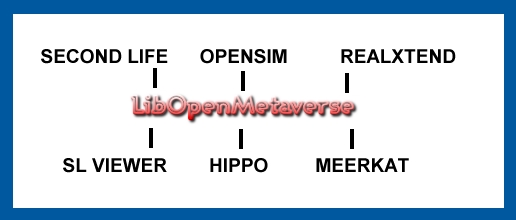I’ve been talking to a few virtual world operators lately that are trumpeting their particular virtual world as the next “Web 3D standard.” They’re the biggest, or the best, or the prettiest, or the fastest, or the cheapest, or whatever — and everyone is going to leave the other worlds and set up shop in theirs.
OpenSim is no exception, by the way. Sure, OpenSim is open source, and supports hypergrid teleportation, but it’s still just one technology platform among many. A fast-growing, cheap technology platform, sure, but still just one.
It takes more than that to set a standard. To me, a new Web 3D standard would have to match what we currently have with HTML, the communication standard for the World Wide Web.
First, we would need to have multiple servers. To host a website, for example, you could use Apache, the open source web server. Or you can use the proprietary Microsoft product. And there are also some other, lesser-known web servers out there.
Second, we would need to have multiple browsers. Websites, for example, can be accessed by Internet Explorer. Firefox. Google Chrome. Safari. And a number of other, lesser-known browsers.
Third, things would need to look pretty much the same no matter what server was running it, or what browser was being used to see it. If you were to look at a website with the menu bar covered up, chances are you wouldn’t be able to tell what browser you were using. And you certainly wouldn’t be able to tell what was powering the website behind the scenes.
Finally, there would need to be some kind of common language somewhere. In the case of the World Wide Web, that common language is HTML in its various incarnations.
So is there a standard for the new 3D Web? Yes, there is, and its called LibOpenMetaverse.
Someday, that will roll of your tongue as easily as HTML does. If “HTML” can be said to roll.
Why is LibOpenMetaverse the new standard?
First, there are multiple servers. Today, Second Life and OpenSim produce worlds to the LibOpenMetaverse standard. So does realXtend, to a lesser extent (it adds mesh functionality, allowing for better graphics — but also creating some compatibility problems).
Second, there are multiple browsers. There’s the Second Life browser of course. And my favorite browser, Hippo. There are also Meerkat and the realXtend browser, and about a dozen other lesser-known ones.
Third, worlds look pretty much the same, once you cover up the menu bars and the rest of the browser branding. Some browsers have prettier menus than others, or add nifty tools, but to the casual user the stuff in the middle will look and act the same. (Except, again, if you’re in a realXtend world and there are mesh-based objects around — non-realXtend browsers won’t display those.)
Fourth, these worlds share a common language. The information sent between the browser and the server is in the form of LibOpenMetaverse instructions.
It is true that the worlds aren’t a perfect fit. Some complex scripts, for example, will run in Second Life but not in OpenSim — and vice versa.
If you recall, back in the early days of the Web, there were pages that worked well in one browser but not in another.
- International singers gather on Alternate Metaverse Grid for first annual International Day - April 15, 2024
- OpenSim hits new land, user highs - April 15, 2024
- Wolf Territories rolls out speech-to-text to help the hearing impaired - April 15, 2024

